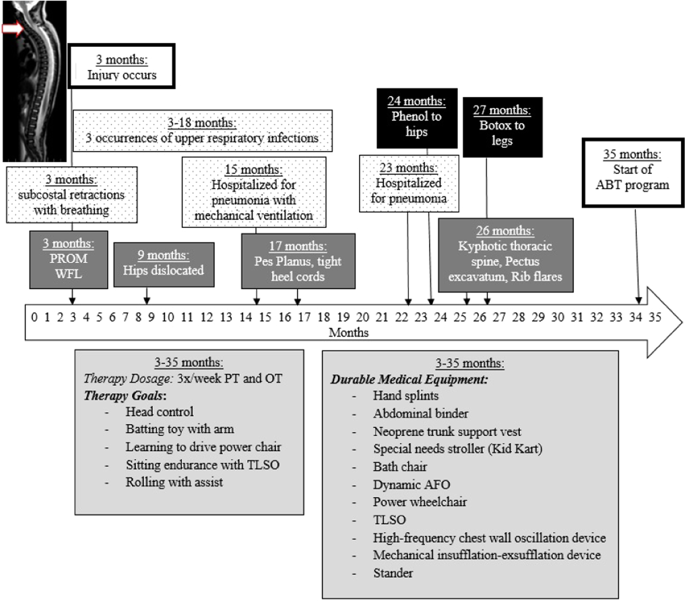Spinal Cord Series and Cases ( IF 0.7 ) Pub Date : 2020-03-10 , DOI: 10.1038/s41394-020-0261-1 Laura C Argetsinger 1 , Goutam Singh 2, 3, 4 , Scott G Bickel 5 , Margaret L Calvery 5 , Andrea L Behrman 2, 3, 4

|
Introduction
Spinal cord injury (SCI) in infancy magnifies the complexity of a devastating diagnosis. Children injured so young have high incidences of scoliosis, hip dysplasia, and respiratory complications leading to poor health and outcomes. We report the medical history, progression of rehabilitation, usual care and activity-based therapy, and outcomes for a child injured in infancy. Activity-based therapy (ABT) aims to activate the neuromuscular system above and below the lesion through daily, task-specific training to improve the neuromuscular capacity, and outcomes for children with acquired SCI.
Case presentation
A 3-month-old infant suffered a cervical SCI from a surgical complication with resultant tetraplegia. Until age 3, her medical complications included scoliosis, kyphosis, and pneumonia. Even with extensive physical and occupational therapy, she was fully dependent on caregivers for mobility and unable to roll, come to sit, sit, stand or walk. She initiated ABT at ~3 years old, participating for 8 months. The child’s overall neuromuscular capacity improved significantly, especially for head and trunk control, contributing to major advances in respiratory health, novel engagement with her environment, and improved physical abilities.
Discussion
From injury during infancy until 3 years old, this child’s health, abilities, and complications were consistent with the predicted path of early-onset SCI. Due to her age at injury, severity and chronicity of injury, she demonstrated unexpected, meaningful changes in her neuromuscular capacity during and post-ABT associated with improved health, function and quality of life for herself and her caregivers.
中文翻译:

婴儿期脊髓损伤:基于活动的治疗对慢性损伤的健康、功能和生活质量的影响
介绍
婴儿期脊髓损伤 (SCI) 放大了毁灭性诊断的复杂性。如此年轻受伤的儿童脊柱侧弯、髋关节发育不良和呼吸系统并发症的发生率很高,导致健康状况和预后不佳。我们报告了婴儿期受伤儿童的病史、康复进展、常规护理和基于活动的治疗以及结果。基于活动的治疗 (ABT) 旨在通过每日针对特定任务的训练来激活病变上方和下方的神经肌肉系统,以提高神经肌肉能力,以及获得性 SCI 儿童的治疗效果。
案例展示
一名 3 个月大的婴儿因手术并发症导致四肢瘫痪而导致颈椎 SCI。直到 3 岁,她的医疗并发症包括脊柱侧弯、后凸畸形和肺炎。即使进行了广泛的物理和职业治疗,她的行动能力也完全依赖于护理人员,无法翻身、坐下、坐下、站立或行走。她在 3 岁左右开始 ABT,参与了 8 个月。孩子的整体神经肌肉能力显着提高,尤其是在头部和躯干控制方面,这有助于呼吸健康、与环境的新接触以及身体能力的改善。
讨论
从婴儿期受伤到 3 岁,这个孩子的健康、能力和并发症与早发性 SCI 的预测路径一致。由于她受伤的年龄、受伤的严重程度和长期性,在 ABT 期间和之后,她的神经肌肉能力出现了意想不到的、有意义的变化,这与她自己和她的照顾者的健康、功能和生活质量的改善有关。











































 京公网安备 11010802027423号
京公网安备 11010802027423号